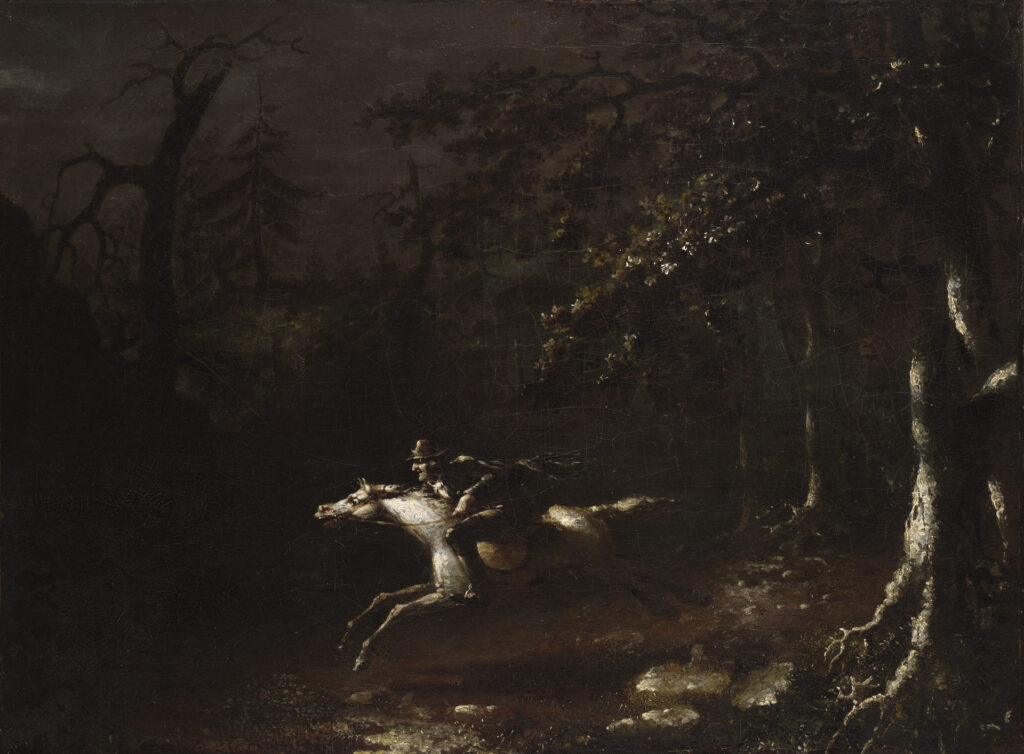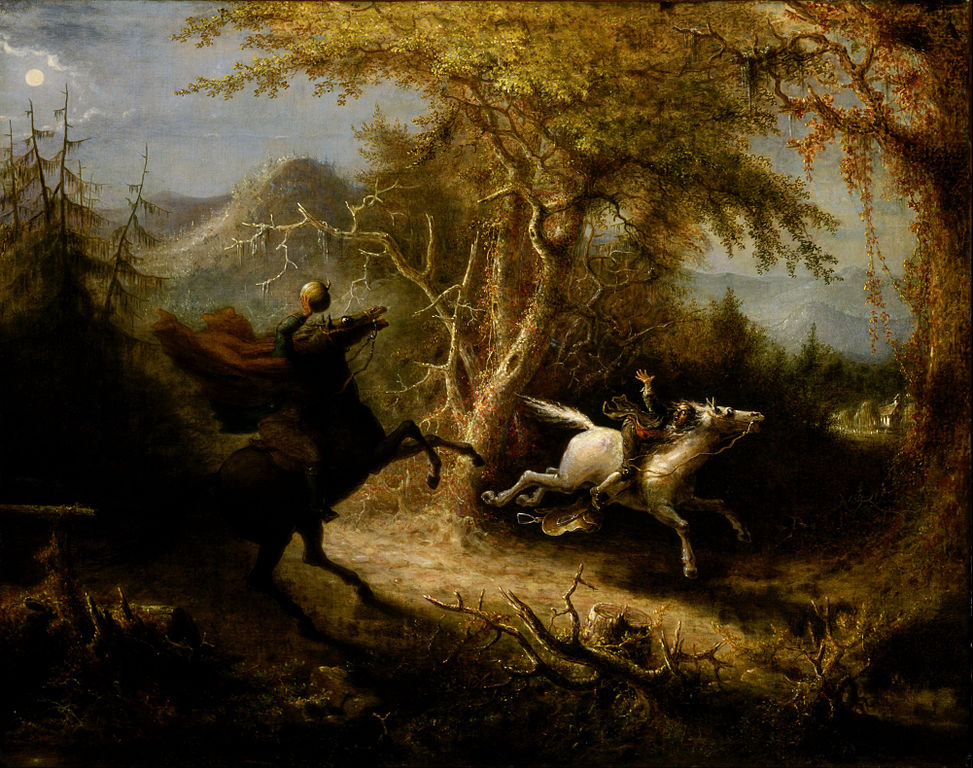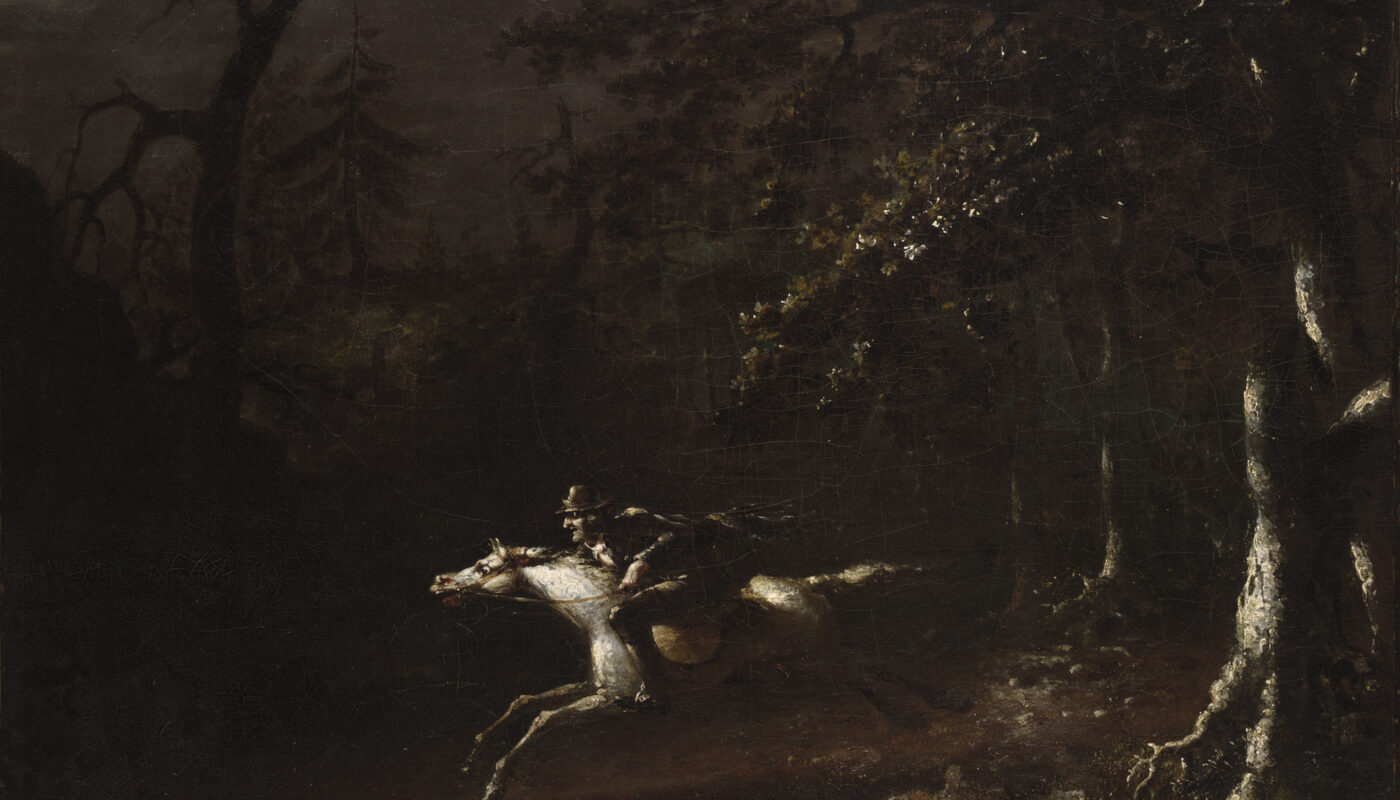Autumn brings its own rituals and customs, like candy corn, scented candles, gathering with loved ones to give thanks, and classic stories. One of those classics, for me, is revisiting Washington Irving’s short story, The Legend of Sleepy Hollow, every October. It’s the one particular Halloween story from my childhood I remember being memorized by, and now, as an adult, I enjoy the craftsmanship Irving displays in bringing the story to life.
Revisiting Books
Being familiar with the arc of a story allows you to dig deeper into the details of that same story. For example, this year I looked into the folk stories Irving references, and discovered two beautiful paintings inspired by the Legend.
There are many layers of interpretation. On the surface we have a story of unrequited love intertwined with a ghost story set in a very superstitious valley, with a protagonist disappearing at the end of a frightfully eventful evening. At a deeper level, we have commentary on the roles and futures of nations. As I’ve written before, some scholars say Crane represents the new American economy, freelance, cobbled together from many sources, and scraping by, where the Dutch heiress Katrina represents old wealth. The rejection of Crane by Katrina represents the anxiety around the new nation and her future status on the world stage.
Great stories, like all great art, invite repeat viewings. There are several reasons we enjoy looking at beautiful paintings or re-watching favorite movies repeatedly. We notice something different each time. Sometimes we pick up on details we missed the first time around, other times we extract new meaning or interpretation because we have grown as people. Every time I re-read a classic story, new connections present themselves to me from the stories or material I’ve learned since the last visit. In some ways, it’s like revisiting your hometown – it may have gained a new shop or traffic light, but it feels like the same place. At the same, though, you yourself have certainly changed by gaining the perspective which comes from moving away from your hometown. Those small shifts make all the difference upon your return.
While nostalgia is great reason to revisit beloved stories, reading books multiple times is also beneficial. It allows us to notice details we missed the first pass through, and gives us an opportunity to think more fully through the arguments or consequences the book advocates or cautions against.
Only One of These can be True
This particular story endures because it is open-ended and shrouded in mystery. It also depicts memorable characters who are hilarious and fascinating in their own ways. We know that Ichabod is never seen in Sleepy Hollow again, after the eventful night of the van Tassels’ party. However, the short story sets up two plausible conclusions, only one of which can be true. The first option is that Brom von Bones played a trick on our schoolmaster, himself dressing up as the Horseman and throwing a pumpkin at Ichabod. This is plausible because we know Brom is familiar with the Headless Horseman legend, having told of his encounter with the apparition at the party. Brom being jilted by Katrina at the party gave him reason to want to scare the pedagogue away from the Hollow. We also know Brom left the party before Ichabod, presumably giving him time to dress the part and wait for Ichabod. We also know Ichabod is from Connecticut, not New York, and would have connections to another place he could return to live after leaving Sleepy Hollow. At the very end of the tale, our narrator, Knickerbocker, teases that a farmer passed along a rumor of a mortified Crane having become a lawyer and judge and moving to a remote part of the New England countryside.
The second option, of course, is that this Headless Horseman truly exists, and after terrorizing and chasing our protagonist, took him to wherever exactly such monstrosities return when they aren’t terrorizing riders along the road. It would seem that the smashed pumpkin next to Ichabod’s hat in the road was an ominous warning to those who would ride along the road at night. The legend existed before Ichabod, and it certainly exists after Ichabod’s disappearance.
Truth and Myth
What makes The Legend of Sleepy Hollow so effective?
There are several things working together to make this story iconic, and enjoyable for repeated readings. It’s cemented itself in American imagery, and American history as one of the earliest ghost stories of the young nation. That iconic headless figure; the lankiness and superstition of Ichabod; his interest in Katrina, and his rival, Brom, winning her away from him – all of these things blend together to create a story which works on several levels. Most of all, the blend of true history and inventive folklore make this story stand apart from other American myths.
Like any good Halloween story, it takes place in a cozy setting and incorporates both truth and myth. The coziness welcomes the autumnal season and invites candle light reading while sipping apple cider. The original short story, as is usually the case, develops a richness and covers more ground than any subsequent movie or other work is capable of doing. Irving weaves together history and myth, creating a ghostly, unsettled feeling.
The drowsiness and superstition of the Hollow means you can’t quite trust the eyes and ears of the people who dwell there. Did they really hear hooves galloping or was it distant thunder? Are they really awake enough to recognize particular sights and sounds? Did they really see a headless figure, or maybe the rider was hunched over, creating an odd shape from a distance? Irving punctuates this early in the book with Ichabod mistaking the sounds of the forest for terrifying beings.
However, Major Andre was actually killed in the woods near this setting, and ghost sightings around Major Andre’s tree and the appearances of woman in white at Raven Rock have actually been reported. There really is part of the Hudson River called Tappan Zee; Sleepy Hollow did and does exist in New York. Then we have Ichabod’s interest and study in the occult – has someone conjured this rider from the great beyond? Are Ichabod’s studies totally harmless, an eccentricity and nothing more? Has he just managed to scare himself on his return home? It’s blending all of these stories, figures, and ideas together which makes the Legend itself so mysterious and fun to explore.
The vague conclusion allows the reader to imagine what might have happened. If you’re more fantastical, maybe you believe the headless horseman found a victim in Crane. If not, maybe Brom played a cruel joke on Ichabod, and the schoolteacher left town quickly and quietly as a result. Either way, we know Ichabod did not win the fair maiden and wasn’t heard from again.
Irving closes his tale with a humorous tone, the perfect balance to the sights we’ve just encountered, and gives us two routes of closure. Without the post-story commentary we don’t really know what to think of Ichabod and Sleepy Hollow. “I don’t believe one half of it myself,” is a marvelous ending line, alluding to the fact that only one of the two possible conclusions can be true. A fittingly clever final line.
More than a Fiction Writer
In light of all his balance and witting choices, it’s hard to believe Irving was a struggling author in 1818 when he wrote The Legend of Sleepy Hollow, which first appeared in The Sketch Book of Geoffrey Crayon, Gentleman. He wrote this collection of stories hoping to make enough money to bail out the family business. Fortunately, Sketch Book proved popular with both American and British audiences and critics, and became the first international best-seller written by an American. Renowned authors Sir Walter Scott and Henry Wadsworth Longfellow both raved about the book, the latter crediting it with sparking his interest in writing literature.
English critics especially loved the stories. “Everywhere I find in it the marks of a mind of the utmost elegance and refinement,” wrote the English historian William Godwin, “a thing as you know that I was not exactly prepared to look for in an American.” Irving, in turn, was stunned to have delighted the English critics: “I am astonished at the success of my writings in England,” Irving wrote to his publisher, “and can hardly persuade myself that it is not all a dream. Had any one told me a few years since in America, that any thing I could write would interest such men as . . . Byron, I should have as readily believed a fairy tale.” (in a letter he wrote to John Murray II in 1820.)
Influence
While Irving is most celebrated today for his Rip van Winkle and Ichabod Crane characters of fiction, he went on to write many historical works and served as a statesman in Europe. His biography of George Washington was so well-received, it secured Irving a position with audiences and critics as a respected historical writer, in addition to his standing as a wonderful fiction writer. Irving lived in Europe from 1815 to 1829, while serving at the US Embassies in England and Spain. Irving was the first Spanish-speaking US ambassador. He became attaché in Madrid in 1826, then continued his diplomatic career in London from 1829 to 1832. He also wrote History of the Life and Voyages of Christopher Columbus in 1828, the Chronicle of the Conquest of Grenada in 1829, and The Alhambra in 1832 during this time. As you can see from the titles of these works, Irving became interested in Spanish history and culture while living in the historic country, and wrote several books on the history of the Moors, as well.

The Legend of Sleepy Hollow has inspired countless reinterpretations and celebrations in the years since it was published. An additional bonus to reading stories written so long ago is the opportunity to see interpretations of the same story over the years. As I was researching the influence Irving’s Legend has had, I came across two paintings by John Quidor, each inspired by the spooky legend and completed just a few years after the story was published. The first painting shows Ichabod alone and fleeing for his life. What is so striking about the image is the lack of color. The forest is incredibly dark, and details are remarkably difficult to distinguish – just as they would have been for our pedagogue. The only color visible is white – the color of Ichabod’s pale horse; the moon’s beams gleaming off Gunpowder’s coat, shining against the glossy leaves of the trees and reflecting off the rocks along the path. While we don’t see the reason, we sense that this rider is in a hurry, and there is an ominous quality hanging over the scene. Once we know the title, Ichabod Flying from the Headless Horseman, this quality makes perfect sense. We understand Ichabod has seen the Headless Horseman, but this particular moment is just as the excitement begins.

The second painting depicts the height of the story, where Hans van Ripper’s saddle has fallen off old Gunpowder and Ichabod realizes he’s been had. In the moments leading up to the fateful encounter, the headless rider has taunted Ichabod, matching his pace as the frightened schoolteacher attempts to outrun, then fall behind, the mysterious figure. Ichabod realizes the church is up ahead, on the other side of the bridge, and clings to the hope that arriving at the bridge will ensure his safety.
The moon shines in the upper left corner, illuminating the scene and drawing your eye to Ichabod’s Gunpowder, the white horse in the right foreground. We see a terrorized Ichabod looking behind him, as the saddle falls away from the scandalized horse and rider. Following Ichabod’s line of sight, we see the terrible apparition on a large dark horse. A rider with a long deep red cape draped over wide shoulders, with a lifted arm holding a pale pumpkin aloft, ready to fire at Ichabod.
We see the trail the riders are on, passing through dense woods, branches hanging down and vines and grass reaching up, obscuring the way forward. In the background on the right side, we see a church and cemetery in the distance, the rumored haunt of this Headless Horseman.
“An opening in the trees now cheered him with the hopes that the bridge was at hand. The wavering reflection of a silver star in the bosom of the brook told him he was not mistaken. He saw the walls of the church dimly glaring under the trees beyond. he recollected the place where Brom Bone’s ghostly competitor had disappeared. “If I can but reach that bridge,” thought Ichabod, “I am safe.”Just then he heard the black steed panting and blowing close behind him; he even fancied that he felt his hot breath. Another convulsive kick in the ribs and old Gunpowder sprang upon the bridge; he thundered over the resounding planks; he gained the opposite side; and now Ichabod cast a look behind to see if his pursuer should vanish, according to rule, in a flash of fire and brimstone. Just then he saw the goblin rising in his stirrups, and in the very act of hurling his head at him. Ichabod endeavored to dodge the horrible missile, but too late. It encountered his cranium with a tremendous crash – he was tumbled headlong into the dust, and Gunpowder, the black steed, and the goblin rider, passed by like a whirlwind. “
The next morning, all that is left of Ichabod is his hat, lying next to a smashed pumpkin.
What actually happened? Did Brom Bones terrify Ichabod, culminating in a thrown pumpkin? Or did something more sinister actually heave his head at our lanky teacher?
Curl up and Read
Autumn is the perfect time to catch up on historical reading and October is a perfect time to revisit The Legend of Sleepy Hollow. Dig into history to find out more about the stories you love to revisit, ask questions about the authors who created them, see how the things they inspire differ from or line up with the original, and see what new things you can learn from a story so familiar. You may find a new appreciation for some old stories.




